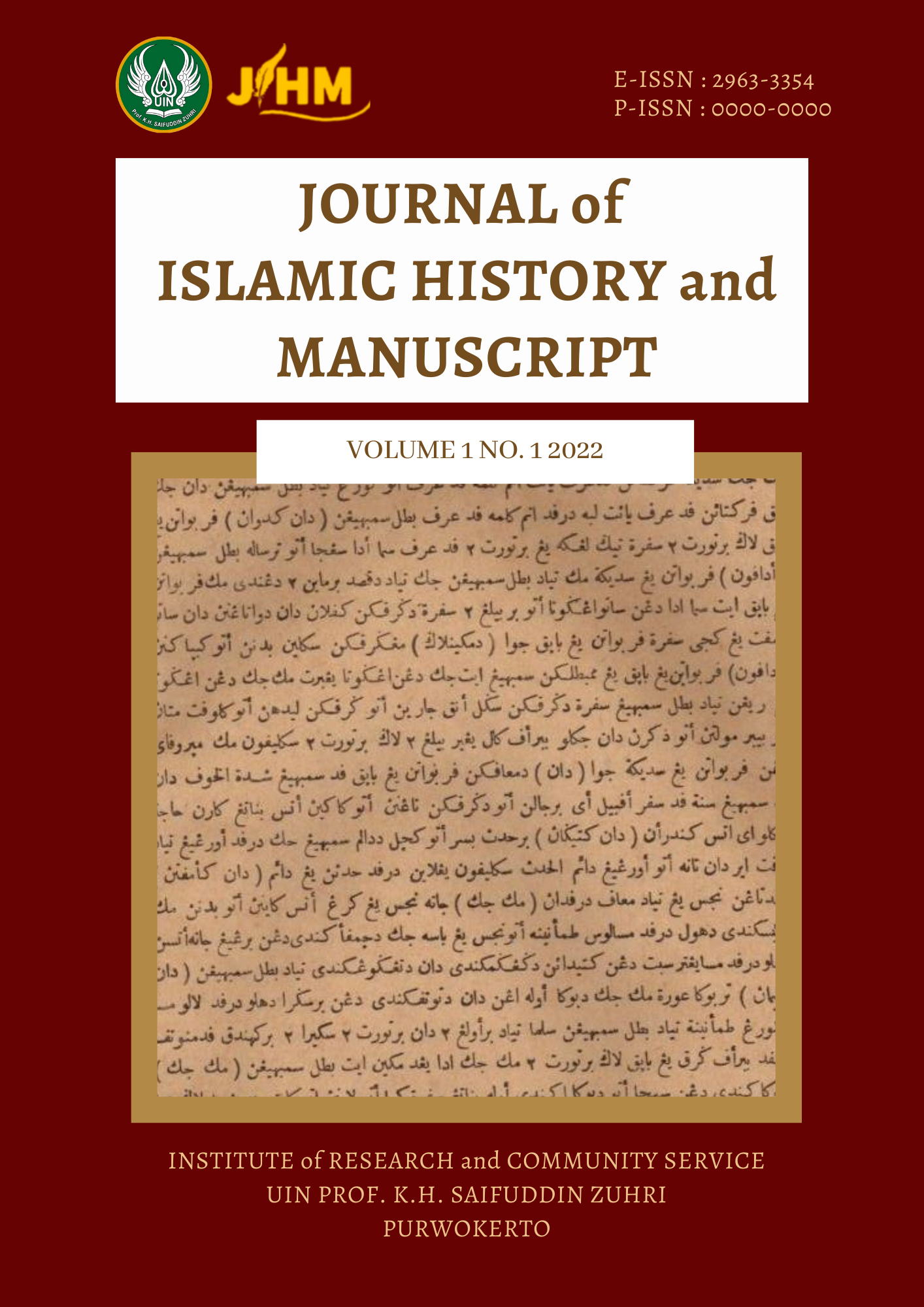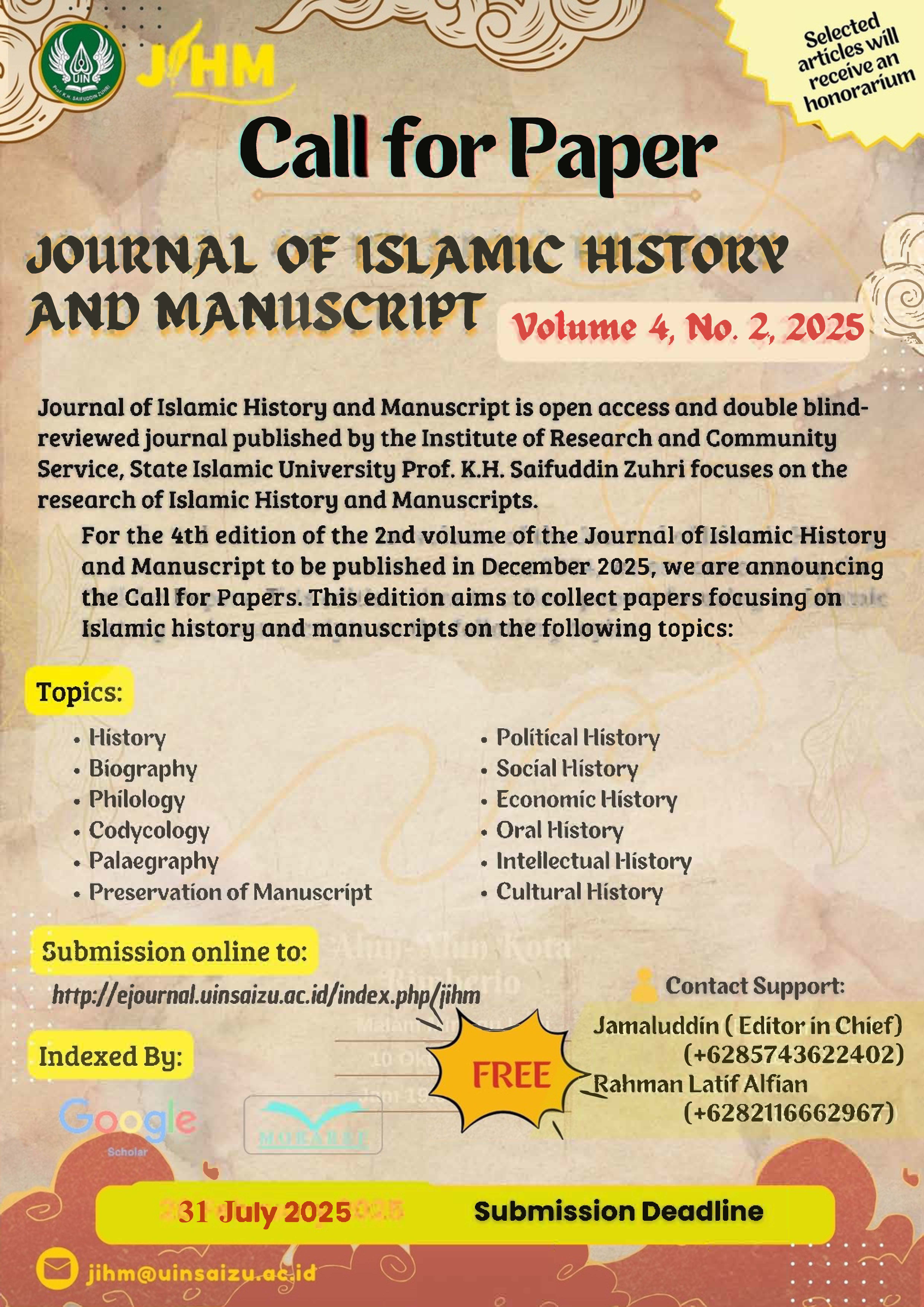Islamic Astronomy of Abbasid Era (750-1258 AD)
DOI:
https://doi.org/10.24090/jihm.v1i1.5944Keywords:
Abbasid State, Astronomy, Muslim ScientistAbstract
Astronomy is a particular field in Islam related to the interests of daily Muslim worship practices, such as determining the beginning of prayer times, qibla direction, and the beginning of the Qamariyah month. During the Abbasid period 750-1258 AD, especially during the reign of Abu Ja'far Al-Mansur, Harun Al-Rashid, and Al-Ma'mun, Islamic astronomy developed significantly. This can be seen from the emergence of astronomers. The love of the three Abbasid caliphs for science significantly influenced the policies related to development in science. The method used in this study is a qualitative method with historical analysis techniques. This study aims to add to the enrichment of historical treasures related to the development of science, especially astronomy, during the Abbasid period. Meanwhile, astronomy during the Abbasid period also had many scientific sources that needed to be studied more comprehensively. That is, many scientific figures in astronomy have never been specifically studied. Therefore, the study of astronomy today in higher education must also seriously focus on learning classical knowledge. This paper discusses the Abbasid state in developing science during its reign by looking at it from the perspective of significant scientific developments during the leadership of its caliph, which was indirectly influenced by socio-religious and intellectual conditions in his time. During the Abbasid era, the progress of science had reached its golden age, especially in Islamic astronomy which had contributed to the development of its science in the field of astronomy in the period after that until now.References
al-Aziz, A. S. (2014). The Complete Book of History of Islamic Civilization. Yogyakarta: Saufa.
al-'Ilm, D. (2011). Atlas of Islamic History. Jakarta: Wisma Hijau.
As-Sirjani, R. (2011). Contribution of Islamic Civilization to the World. Jakarta: Pustaka al-Kautsar.
Butar-butar, A. J. (2013). Islamic Astronomy in the Mamalik Dynasty. Journal of Islamic Sciences Afkaruna.
Fathurrohman, M. (2017). History of Islamic Civilization. Yogyakarta: Garudhawaca.
Gurabi, A. M. (1959). Tarikh al-Firaq al-Islamiyah. Cairo: Mathba'ah Ali Shahih.
Hasan, H. I. (1979). Tarikh al-Islam. Cairo: Maktabah al-Misriyah.
Hasjmi, A. (1993). History of Islamic Culture. Jakarta: Bulan Bintang.
Hitti, P. K. (2018). History of The Arabs, From the Earliest Times to the Present. Jakarta: Zaman.
Karim, M. A. (2011). History of Islamic Thought and Civilization. Yogyakarta: Bagaskara.
Khalil, S. A. (1996). Daur Al-Hadharah Al-Arabiyah Al-Islamiyah fi An-Nahdhah Al-Haditstah. Damascus: Dar Al-Fikr.
Levy, R. (1986). The Social Structure of Islam. Jakarta: Pustaka Firdaus.
Machfud Syaefudin, d. (2013). The Dynamics of Islamic Civilization from a Historical Perspective. Yogyakarta: CV. Pustaka Ilmu Group Yogyakarta.
Stryzewska, B. G. (n.d.). Date al-Daulat al-Islamiyah. Beirut: Al-Maktab Al-Tijari.
Sunanto, M. (2003). In Perkembangan Ilmu Pengetahuan Islam (p. 50). Jakarta: Prenada Media.
Sunanto, M. (2003). Classical Islamic History (Development of Islamic Science). Jakarta: Prenada Media.
Syalabi, A. (1993). History of Islamic Culture. Jakarta: Pustaka al-Husna.
Syuhadak, U. R. (2017). Bahasa Arab di Masa Daulah Umayyah (661-749 M) dan Masa Daulah Abbasid (749-1258 M). Jurnal Arabia IAIN Kudus, 99-100.
Wandi. (2020). History of Islamic Civilization. Klaten: Penerbit Lakeisha.
Watt, W. M. (1990). The Glory of Islam: A Critical Study of Orientalist Figures. Yogyakarta: Tiara Wacana Yogya.
Yatim, B. (2018). History of Islamic Civilization Dirasah Islamiyah II. Depok: Rajawali Pers.
al-'Ilm, D. (2011). Atlas of Islamic History. Jakarta: Wisma Hijau.
As-Sirjani, R. (2011). Contribution of Islamic Civilization to the World. Jakarta: Pustaka al-Kautsar.
Butar-butar, A. J. (2013). Islamic Astronomy in the Mamalik Dynasty. Journal of Islamic Sciences Afkaruna.
Fathurrohman, M. (2017). History of Islamic Civilization. Yogyakarta: Garudhawaca.
Gurabi, A. M. (1959). Tarikh al-Firaq al-Islamiyah. Cairo: Mathba'ah Ali Shahih.
Hasan, H. I. (1979). Tarikh al-Islam. Cairo: Maktabah al-Misriyah.
Hasjmi, A. (1993). History of Islamic Culture. Jakarta: Bulan Bintang.
Hitti, P. K. (2018). History of The Arabs, From the Earliest Times to the Present. Jakarta: Zaman.
Karim, M. A. (2011). History of Islamic Thought and Civilization. Yogyakarta: Bagaskara.
Khalil, S. A. (1996). Daur Al-Hadharah Al-Arabiyah Al-Islamiyah fi An-Nahdhah Al-Haditstah. Damascus: Dar Al-Fikr.
Levy, R. (1986). The Social Structure of Islam. Jakarta: Pustaka Firdaus.
Machfud Syaefudin, d. (2013). The Dynamics of Islamic Civilization from a Historical Perspective. Yogyakarta: CV. Pustaka Ilmu Group Yogyakarta.
Stryzewska, B. G. (n.d.). Date al-Daulat al-Islamiyah. Beirut: Al-Maktab Al-Tijari.
Sunanto, M. (2003). In Perkembangan Ilmu Pengetahuan Islam (p. 50). Jakarta: Prenada Media.
Sunanto, M. (2003). Classical Islamic History (Development of Islamic Science). Jakarta: Prenada Media.
Syalabi, A. (1993). History of Islamic Culture. Jakarta: Pustaka al-Husna.
Syuhadak, U. R. (2017). Bahasa Arab di Masa Daulah Umayyah (661-749 M) dan Masa Daulah Abbasid (749-1258 M). Jurnal Arabia IAIN Kudus, 99-100.
Wandi. (2020). History of Islamic Civilization. Klaten: Penerbit Lakeisha.
Watt, W. M. (1990). The Glory of Islam: A Critical Study of Orientalist Figures. Yogyakarta: Tiara Wacana Yogya.
Yatim, B. (2018). History of Islamic Civilization Dirasah Islamiyah II. Depok: Rajawali Pers.
Downloads
Published
29-06-2022
How to Cite
Aziz, M. I., & Musta'id, A. (2022). Islamic Astronomy of Abbasid Era (750-1258 AD). Journal of Islamic History and Manuscript, 1(1), 35–52. https://doi.org/10.24090/jihm.v1i1.5944
Issue
Section
Articles
License
Authors who publish in this journal agree to the following terms:
- Authors retain copyright and grant the journal right of first publication with the work simultaneously licensed under a Creative Commons Attribution 4.0 International License. that allows others to share the work with an acknowledgment of the work's authorship and initial publication in this journal.
- Authors can enter into separate, additional contractual arrangements for the non-exclusive distribution of the journal's published version of the work (e.g., post it to an institutional repository or publish it in a book), with an acknowledgment of its initial publication in this journal.
- Authors are permitted and encouraged to post their work online (e.g., in institutional repositories or on their website) before and during the submission process, as it can lead to productive exchanges and earlier and greater citation of published work (See The Effect of Open Access).

















